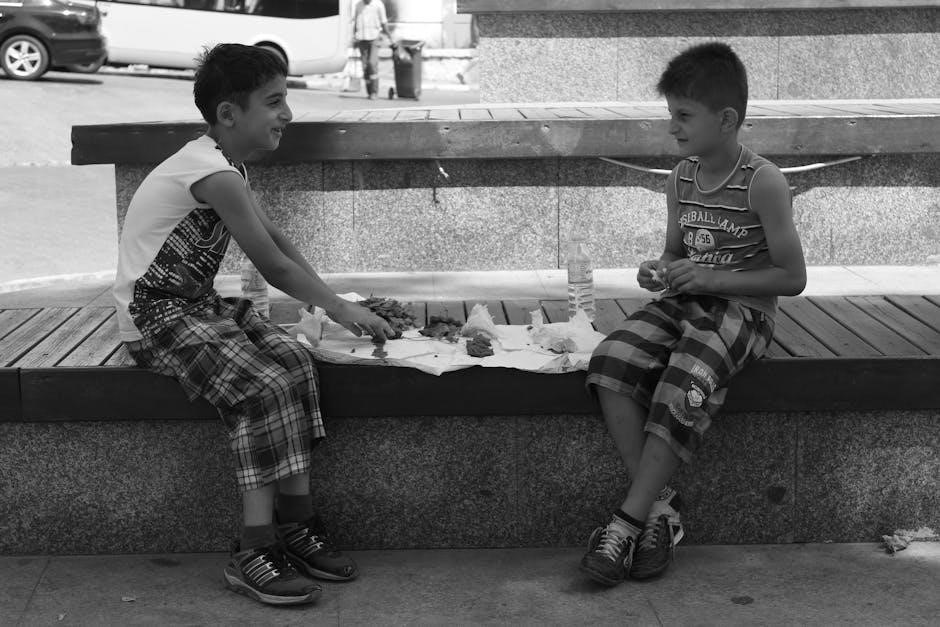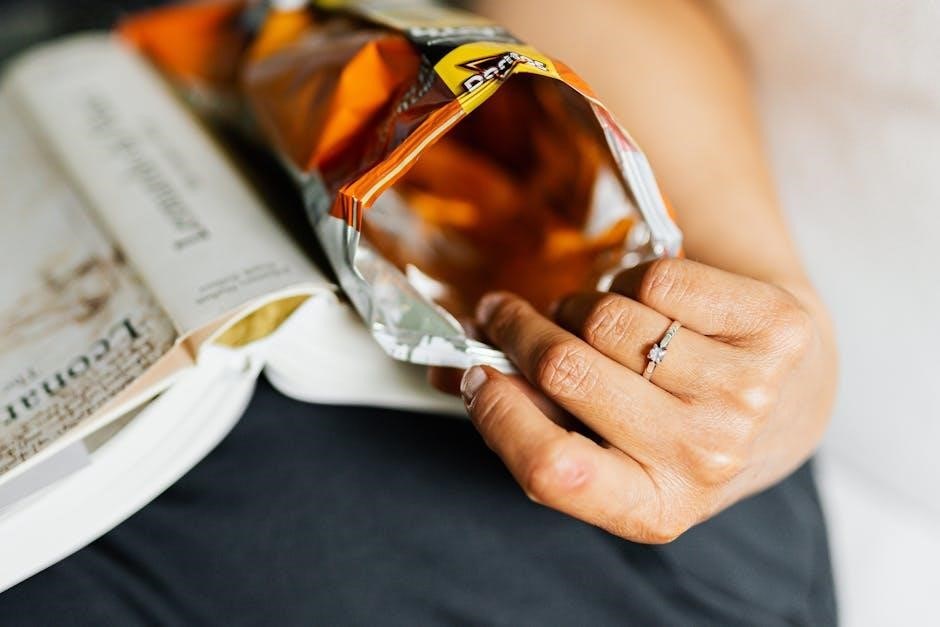The Outsiders, written by S․E․ Hinton in 1967, explores the tumultuous life of Ponyboy Curtis in 1960s Tulsa, delving into themes of class conflict and family bonds․
Overview of the Novel and Its Significance
The Outsiders, written by S․E․ Hinton, is a groundbreaking young adult novel published in 1967․ Set in 1960s Tulsa, Oklahoma, it explores the intense rivalry between two gangs: the working-class “greasers” and the wealthy “Socs” (short for Socials)․ The novel is narrated by Ponyboy Curtis, a 14-year-old greaser, who shares his perspective on class conflict, family struggles, and identity․ Hinton’s vivid portrayal of adolescent struggles resonated with readers, making it a classic in YA literature․ Its raw authenticity and relatable themes continue to captivate audiences, offering insights into social divisions and the challenges of growing up․

Plot Summary of Chapter 1
Ponyboy Curtis walks home alone after watching a movie, reflecting on his life․ He encounters Socs, is attacked, and rescued by his brothers Darry and Sodapop․
Ponyboy Curtis and His Walk Home
Ponyboy Curtis, the 14-year-old narrator, begins the novel by describing his solitary walk home from a movie theater․ He had just watched a Paul Newman film, a moment of escape from his harsh reality․ Walking alone, Ponyboy feels vulnerable, aware of the dangers faced by greasers like himself․ His thoughts drift to his brothers and the social divide between greasers and Socs․ The setting sun casts long shadows, symbolizing the contrast between his peaceful afternoon and the impending conflict․ This walk sets the stage for the violent encounter that will change everything․
The Encounter with the Socs
As Ponyboy walks home, a blue Mustang pulls up, and he is confronted by a group of Socs, the rival gang from the wealthier side of town․ The Socs, seeking revenge for earlier conflicts, taunt and attack him․ Ponyboy is beaten brutally, his fear escalating as he realizes the gravity of the situation․ Just as the Socs threaten to cut his hair, a symbolic humiliation, his brothers Darry and Sodapop arrive, chasing the attackers away․ The rescue highlights the strong bond between the Curtis brothers and sets the tone for the ongoing rivalry between greasers and Socs․
Rescue and Aftermath

Darry and Sodapop arrive just in time to chase the Socs away, saving Ponyboy from further harm․ Shaken, Ponyboy returns home, where Darry’s concern for his safety boils over into frustration․ Despite Ponyboy’s resentment, Darry’s strictness stems from a desire to protect him․ The slap Darry gives Ponyboy symbolizes the tension between his brotherly love and the harsh realities of their life without parents․ This moment underscores the emotional strain and sacrifices within the Curtis family, highlighting their struggle to cope with loss and responsibility․
Ponyboy Curtis, the narrator, is a sensitive and thoughtful teenager․ His brothers, Darry and Sodapop, represent responsibility and carefree spirit․ Friends Steve, Two-Bit, and Dallas add toughness and humor to the group․

Ponyboy Curtis: The Narrator and Protagonist
Ponyboy Curtis, the 14-year-old narrator, is a sensitive and thoughtful teenager who loves literature and movies․ As the youngest Curtis brother, he struggles with his identity, caught between childhood and adulthood․ His introspective nature contrasts with the tough greaser image, showcasing his depth․ Ponyboy’s love for learning and creativity sets him apart, while his loyalty to family and friends drives his decisions․ His perspective shapes the story, offering a heartfelt and emotional lens through which the conflicts and bonds of the greasers are revealed․
Darry Curtis: The Responsible Older Brother
Darry Curtis, Ponyboy’s older brother, is portrayed as a responsible and disciplined figure․ After their parents’ death, Darry assumed a parental role, working hard to support his brothers․ His strict demeanor often clashes with Ponyboy, who feels misunderstood․ Darry’s tough exterior hides a deep care for his family, particularly Ponyboy, as seen when he slaps him out of concern for his safety․ This incident highlights Darry’s protective nature and the challenges of balancing responsibility with brotherly love․ His character establishes the theme of sacrifice and the burdens of growing up too quickly․
Sodapop Curtis: The Carefree Brother
Sodapop Curtis, the middle brother, is a fun-loving and carefree member of the Curtis family․ He works at a gas station and enjoys simple pleasures like movies and soda․ Unlike Darry, Sodapop is lighthearted, often mediating between his brothers with humor․ His easygoing nature makes him a peacemaker, and he is deeply loyal to both Ponyboy and Darry․ Sodapop’s carefree exterior hides a sensitive side, as he regrets dropping out of school․ His character represents the joy and resilience that balance the family’s struggles, making him a beloved figure in Ponyboy’s life and a key member of the greaser gang․
Steve Randle, Two-Bit Matthews, and Dallas Winston
Steve Randle, Sodapop’s best friend, is a laid-back greaser who loves cars but often treats Ponyboy like a child․ Two-Bit Matthews, known for his jokes and mischievous grin, enjoys fighting and frequently gets into trouble with the law․ Dallas Winston, the toughest and most dangerous member of the gang, has a reputation for being fearless and unpredictable, having been arrested at just ten years old․ Together, they form a dynamic group, each contributing their unique personalities to the greaser gang․ Their interactions with Ponyboy highlight their protective yet rough demeanor, shaping his view of loyalty and brotherhood in their shared world․

Themes in Chapter 1
Class conflict and societal divides are introduced, highlighting the tension between greasers and Socs․ Family bonds and loyalty are also central, showcasing the Curtis brothers’ unity despite hardships․
Class Conflict: Greasers vs․ Socs
The rivalry between greasers and Socs dominates Chapter 1, reflecting deep social divisions․ Greasers, like Ponyboy, face economic hardships and prejudice, while Socs enjoy privilege and wealth․ This clash is evident when Ponyboy is attacked, highlighting the dangerous tension between the two groups․ The Socs’ aggression symbolizes their disdain for the greasers’ lower status, while the greasers’ resilience underscores their struggle for respect in a society that often marginalizes them․ This conflict sets the stage for the novel’s exploration of social inequality and identity․
Family and Brotherhood
In Chapter 1, Ponyboy’s narrative emphasizes the importance of family and brotherhood․ After their parents’ death, the Curtis brothers—Ponyboy, Darry, and Sodapop—rely on each other for support․ Darry, the eldest, takes on a parental role, while Sodapop embodies carefree youth․ Ponyboy admires their unity, reflecting on how their bond strengthens them against adversity․ The rescue by his brothers and friends highlights the deep loyalty within their group, showcasing a sense of family that extends beyond blood ties․ This camaraderie becomes a source of strength, underscoring the novel’s themes of resilience and the power of brotherhood in the face of hardship․

Symbolism and Imagery
The movie theater symbolizes Ponyboy’s escape from reality, while the contrast between sunlight and darkness reflects the societal divide and internal conflicts, reinforcing themes of class struggle and personal turmoil․
The Movie Theater as an Escape
The movie theater serves as Ponyboy’s refuge, offering a temporary escape from his harsh reality․ Alone, he immerses himself in films, finding solace in their stories and characters․ This solitude allows him to reflect and process his emotions, providing a mental break from the tensions of gang conflicts and family struggles․ The theater symbolizes a space where Ponyboy can disconnect from the societal divisions and personal hardships, highlighting his introspective nature and desire for transcendence through storytelling․ This escape underscores his sensitivity and longing for a world beyond the Greaser-Soc rivalry․
The Sunlight and Darkness Contrast
The stark transition from the movie theater’s darkness to the blinding sunlight symbolizes Ponyboy’s shift from an immersive, imaginative world to the harsh realities of his life․ The bright light represents innocence and normalcy, while the shadows of the Socs’ threat embody danger and conflict․ This contrast underscores the fragility of Ponyboy’s safe spaces and the abruptness with which violence can disrupt his peaceful moments․ The interplay of light and dark foreshadows the ongoing struggle between hope and despair, innocence and reality, that shapes Ponyboy’s journey throughout the novel․

Writing Style and Narrative Voice
Ponyboy’s reflective and emotional narrative voice creates a deeply personal tone, immersing readers in his thoughts and feelings through his introspective first-person perspective․

Ponyboy’s Reflective and Emotional Tone
Ponyboy’s narrative voice is deeply introspective, filled with emotional depth as he contemplates life, social divisions, and personal struggles․ His thoughts reveal a sensitive soul, often lost in reflection, whether it’s about movies, family, or the clash between greasers and Socs․ His emotional tone is raw and honest, capturing the turmoil of adolescence and the harsh realities of his world․ Through his internal monologue, readers experience his pain, hope, and resilience, making his character relatable and human․ This reflective tone sets the stage for the novel’s exploration of identity and class conflict, drawing readers into Ponyboy’s poignant journey․

Historical and Cultural Context
The Outsiders is set in 1960s Tulsa, Oklahoma, reflecting the economic and social divisions between working-class “greasers” and affluent “Socs,” highlighting the era’s cultural tensions and conflicts․
1960s Tulsa and Social Divisions
The novel is set in 1960s Tulsa, Oklahoma, a city marked by stark social divisions․ The “greasers,” like Ponyboy and his brothers, are from the poorer, working-class East Side, while the “Socs” (short for Socials) are wealthier teenagers from the West Side․ This division is rooted in economic disparities and cultural differences, with the greasers often facing discrimination and violence․ The rivalry between the two groups reflects the broader societal tensions of the time, including class conflict and the struggle for identity among youth in a rapidly changing world․
